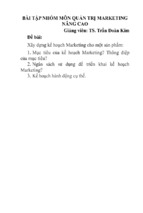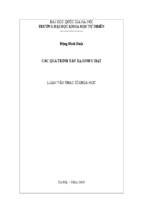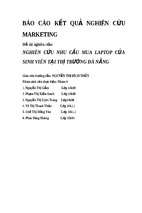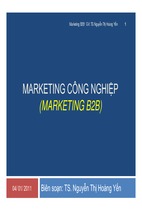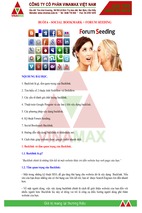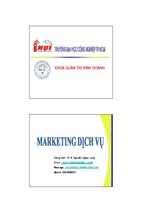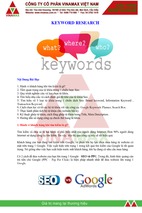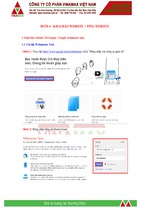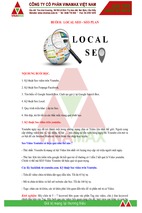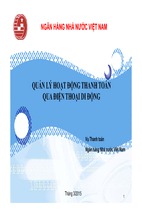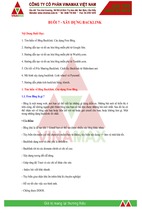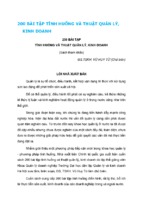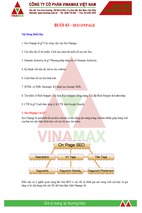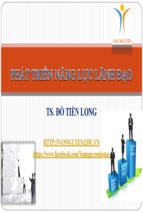Letter
from the AUthorS
Dear Business Students:
How do you define success? For some, success is a high-paying job, promotions, and
financial security. For others, success is finding a rewarding balance between work and
personal time. Regardless of how you define success or what your personal goals are, we
wrote this text with one purpose: to help you succeed in today’s competitive business world.
As authors, we believe that success is measured not only by the grade you receive at the
end of the semester, but also by how you use the information and concepts in this text to
build a foundation for a better life. It is important to begin reading this text with one thing in
mind. This business course doesn’t have to be difficult. In fact, learning about business and
how you can become successful can be fun. To help you succeed, this edition of Business is
packed with updated content and information that can help you not only get a better grade,
but also help you reach your personal goals and enjoy a successful life.
We worked hard to make sure there is something in every chapter to help you understand
the world of business and become a better employee, a more informed consumer, and, if it is
your dream—a successful business owner. All new boxed features help reinforce the success
theme, including Career Success, Ethical Success or Failure, Entrepreneurial Success, and
Going for Success. You can also use the chapter summary, review and discussion questions,
and case problems to reinforce important concepts. And the activities in the Building Skills for
Career Success section will help to improve the skills you need for success.
We are especially proud of the CourseMate Web site that accompanies the text. The Web
site contains more student learning activities and an eBook—all designed to help you
experience success. For those who want even more state-of-the-art technology, there are other
online solutions that accompany this text, including MindTap and CengageNOW. A number
of learning activities—all designed to help you to experience success—are available at
CengageBrain.com. There you will find:
•
•
•
•
•
•
Make the Grade
with CourseMate
Engaging. Trackable. Affordable.
CourseMate features:
Interactive Learning Tools:
Interactive quizzes
Student PowerPoint slides
Links to videos
Chapter audio reviews
Games and crossword puzzles
Interactive flashcards
• Quizzes
• Flashcards
• Videos
Interactive eBook:
• Take notes, highlight, search, and interact
with embedded media specific to your book.
• Use it as a supplement to the printed text, or
as a substitute — the choice is yours.
We invite you to examine the visual guide that follows to see how Pride/Hughes/Kapoor can
help you learn about business and enjoy success in not only your career, but also your life.
Sincerely
Bill Pride
[email protected]
The more you study, the better the results. Make the most
of your study time by accessing everything you need to
succeed in one place. Read your textbook, take notes, review
flashcards, watch videos, and take practice quizzes—online
with CourseMate.
Bob Hughes
[email protected]
Jack Kapoor
[email protected]
To purchase access, visit
www.cengagebrain.com
Copyright 2012 Cengage Learning. All Rights Reserved. May not be copied, scanned, or duplicated, in whole or in part. Due to electronic rights, some third party content may be suppressed from the eBook and/or eChapter(s). Editorial review has
deemed that any suppressed content does not materially affect the overall learning experience. Cengage Learning reserves the right to remove additional content at any time if subsequent rights restrictions require it.
BUSINESS
T wel f t h
E d iti o n
William M. Pride
Texas A&M University
Robert J. Hughes
Dallas County Community Colleges
Jack R. Kapoor
College of DuPage
Australia • Brazil • Japan • Korea • Mexico • Singapore • Spain • United Kingdom • United States
Copyright 2012 Cengage Learning. All Rights Reserved. May not be copied, scanned, or duplicated, in whole or in part. Due to electronic rights, some third party content may be suppressed from the eBook and/or eChapter(s). Editorial review has
deemed that any suppressed content does not materially affect the overall learning experience. Cengage Learning reserves the right to remove additional content at any time if subsequent rights restrictions require it.
Business, Twelfth Edition
William M. Pride, Robert J. Hughes,
Jack R. Kapoor
Senior Vice President, LRS/Acquisitions &
Solutions Planning: Jack W. Calhoun
Editorial Director, Business & Economics:
Erin Joyner
© 2014, 2012 South-Western, Cengage Learning
ALL RIGHTS RESERVED. No part of this work covered by the copyright herein may
be reproduced, transmitted, stored, or used in any form or by any means graphic,
electronic, or mechanical, including but not limited to photocopying, recording,
scanning, digitizing, taping, web distribution, information networks, or information
storage and retrieval systems, except as permitted under Section 107 or 108 of the 1976
United States Copyright Act, without the prior written permission of the publisher.
Acquisitions Editor: Jason Fremder
Managing Developmental Editor:
Joanne Dauksewicz
Editorial Assistant: Megan Fischer
Brand Manager: Robin Lefevre
Market Development Manager: Jonathan
Monahan
Sr. Content Project Manager: Emily
Nesheim, Holly Henjum
Supervising Media Editor: Scott Fidler
Manufacturing Planner: Ron Montgomery
Production Service: Integra Software
Services, LLC
Sr. Art Director: Stacy Jenkins Shirley
Cover and Internal Designer: Joe Devine/
Red Hangar Design
For product information and technology assistance, contact us at Cengage
Learning Customer & Sales Support, 1-800-354-9706
For permission to use material from this text or product,
submit all requests online at www.cengage.com/permissions
Further permissions questions can be emailed to
[email protected]
ExamView® is a registered trademark of eInstruction Corp. Windows is a registered
trademark of the Microsoft Corporation used herein under license. Macintosh and
Power Macintosh are registered trademarks of Apple Computer, Inc. used herein
under license.
© 2008 Cengage Learning. All Rights Reserved.
Library of Congress Control Number: 2012947815
Cover Image: © Jorg Greuel/Getty Images
ISBN-13: 978-1-133-59585-4
ISBN-10: 1-133-59585-5
Rights Acquisitions Specialist: Deanna
Ettinger
Looseleaf Version ISBN 13: 978-1-133-93667-1
Looseleaf Version ISBN 10: 1-133-93667-9
South-Western
5191 Natorp Boulevard
Mason, OH 45040
USA
Cengage Learning is a leading provider of customized learning solutions with
office locations around the globe, including Singapore, the United Kingdom, Australia,
Mexico, Brazil, and Japan. Locate your local office at: www.cengage.com/global
Cengage Learning products are represented in Canada by Nelson Education, Ltd.
For your course and learning solutions, visit www.cengage.com
Purchase any of our products at your local college store or at our preferred online store
www.cengagebrain.com
Printed in the United States of America
1 2 3 4 5 6 7 16 15 14 13 12
Copyright 2012 Cengage Learning. All Rights Reserved. May not be copied, scanned, or duplicated, in whole or in part. Due to electronic rights, some third party content may be suppressed from the eBook and/or eChapter(s). Editorial review has
deemed that any suppressed content does not materially affect the overall learning experience. Cengage Learning reserves the right to remove additional content at any time if subsequent rights restrictions require it.
This is an electronic version of the print textbook. Due to electronic rights restrictions, some third party content may be suppressed. Editorial
review has deemed that any suppressed content does not materially affect the overall learning experience. The publisher reserves the right to
remove content from this title at any time if subsequent rights restrictions require it. For valuable information on pricing, previous
editions, changes to current editions, and alternate formats, please visit www.cengage.com/highered to search by
ISBN#, author, title, or keyword for materials in your areas of interest.
Copyright 2012 Cengage Learning. All Rights Reserved. May not be copied, scanned, or duplicated, in whole or in part. Due to electronic rights, some third party content may be suppressed from the eBook and/or eChapter(s). Editorial review has
deemed that any suppressed content does not materially affect the overall learning experience. Cengage Learning reserves the right to remove additional content at any time if subsequent rights restrictions require it.
To Nancy, Allen, Mike, Ashley, and Charlie Pride
To my wife Peggy and to my mother Barbara Hughes
To my wife Theresa; my children Karen, Kathryn, and Dave; and in
memory of my parents Ram and Sheela Kapoor
Copyright 2012 Cengage Learning. All Rights Reserved. May not be copied, scanned, or duplicated, in whole or in part. Due to electronic rights, some third party content may be suppressed from the eBook and/or eChapter(s). Editorial review has
deemed that any suppressed content does not materially affect the overall learning experience. Cengage Learning reserves the right to remove additional content at any time if subsequent rights restrictions require it.
Copyright 2012 Cengage Learning. All Rights Reserved. May not be copied, scanned, or duplicated, in whole or in part. Due to electronic rights, some third party content may be suppressed from the eBook and/or eChapter(s). Editorial review has
deemed that any suppressed content does not materially affect the overall learning experience. Cengage Learning reserves the right to remove additional content at any time if subsequent rights restrictions require it.
Brief CONtents
1
The Environment of Business
1. Exploring the World of Business and Economics
2. Being Ethical and Socially Responsible
3. Exploring Global Business
2
3
4
5
6
7
1
2
35
69
Business Ownership and Entrepreneurship
103
4. Choosing a Form of Business Ownership
5. Small Business, Entrepreneurship, and Franchises
104
133
Management and Organization
163
6. Understanding the Management Process
7. Creating a Flexible Organization
8. Producing Quality Goods and Services
164
188
211
Human Resources
243
9. Attracting and Retaining the Best Employees
10. Motivating and Satisfying Employees and Teams
11. Enhancing Union–Management Relations
244
273
302
Marketing
329
12. Building Customer Relationships Through Effective Marketing
13. Creating and Pricing Products That Satisfy Customers
14. Wholesaling, Retailing, and Physical Distribution
15. Developing Integrated Marketing Communications
330
357
394
423
Social Media, e-Business, and Accounting
455
16. Exploring Social Media and e-Business
17. Using Management and Accounting Information
456
486
Finance and Investment
519
18. Understanding Money, Banking, and Credit
19. Mastering Financial Management
20. Understanding Personal Finances and Investments
520
550
579
Glossary
Name Index
Subject Index
615
627
634
The following appendixes appear on the companion site www.cengage.brain.com
Appendix A: Careers in Business
Appendix B: Risk Management and Insurance
Appendix C: Business Law, Regulation, and Taxation
v
Copyright 2012 Cengage Learning. All Rights Reserved. May not be copied, scanned, or duplicated, in whole or in part. Due to electronic rights, some third party content may be suppressed from the eBook and/or eChapter(s). Editorial review has
deemed that any suppressed content does not materially affect the overall learning experience. Cengage Learning reserves the right to remove additional content at any time if subsequent rights restrictions require it.
CONtents
1
The Environment of Business 1
Chapter 1: Exploring the World
of Business and Economics 2
Inside Business: Zynga Zooms into Business 3
Your Future in the Changing World of Business 4
Why Study Business?, 5
Career Success: Show Off Your Skills with Digital Merit Badges 6
Special Note to Business Students, 8
Business: A Definition 10
The Organized Effort of Individuals, 10 • Satisfying Needs, 10 • Business Profit, 11
Chapter 2: Being Ethical and
Socially Responsible 35
Inside Business: Panera Cares About Its Communities 36
Business Ethics Defined 37
Ethical Issues 37
Fairness and Honesty, 38 • Organizational Relationships, 38 • Conflict of
Interest, 39 • Communications, 39
Factors Affecting Ethical Behavior 39
Individual Factors Affecting Ethics, 40 • Social Factors Affecting Ethics, 40 •
“Opportunity” as a Factor Affecting Ethics, 40
Sustaining the Planet: Honda: Not Just Another Automobile
Manufacturer 12
Types of Economic Systems 12
Encouraging Ethical Behavior 41
Entrepreneurial Success: Building a Million-Dollar App Business 13
Social Responsibility 44
The Evolution of Social Responsibility in Business 47
Capitalism, 14 • Capitalism in the United States, 15 • Command Economies, 16
Measuring Economic Performance 17
The Importance of Productivity in the Global Marketplace, 18 • The Nation’s Gross
Domestic Product, 18 • Important Economic Indicators that Measure a Nation’s
Economy, 19
The Business Cycle 20
Types of Competition 21
Perfect Competition, 22 • Monopolistic Competition, 23 • Oligopoly, 24 •
Monopoly, 24
American Business Today 24
Early Business Development, 25 • Business Development in the 1900s, 25
• A New Century: 2000 and Beyond, 26 • The Current Business Environment, 26
• The Challenges Ahead, 27
Return to Inside Business: Zynga 28
Summary 29
Key Terms 30
Review Questions 30
Discussion Questions 31
Video Case 1.1: Entertainment Means Profits for Nederlander
Concerts 31
Case 1.2: The Walt Disney Company Entertains the World 32
Building Skills for Career Success 32
Endnotes 33
Government’s Role in Encouraging Ethics, 41 • Trade Associations’ Role in
Encouraging Ethics, 41 • Individual Companies’ Role in Encouraging Ethics, 41
Historical Evolution of Business Social Responsibility, 47
Two Views of Social Responsibility 49
The Economic Model, 49 • The Socioeconomic Model, 49 • The Pros and Cons
of Social Responsibility, 49
Consumerism 51
The Six Basic Rights of Consumers, 51 • Major Consumerism Forces, 52
Ethical Success or Failure?: Is Personal Data Really Private? 53
Employment Practices 55
Affirmative Action Programs, 55 • Training Programs for the Hard-Core
Unemployed, 56
Concern for the Environment 57
Effects of Environmental Legislation, 57
Sustaining the Planet: Social Responsibility at Xerox 59
Entrepreneurial Success: Social Entrepreneurs of Tomorrow 61
Who Should Pay for a Clean Environment?, 61
Implementing a Program of Social Responsibility 61
Developing a Program of Social Responsibility, 61 • Funding the Program, 62
Return to Inside Business: Panera Cares 63
Summary 63
Key Terms 64
Review Questions 64
Discussion Questions 65
vi
Copyright 2012 Cengage Learning. All Rights Reserved. May not be copied, scanned, or duplicated, in whole or in part. Due to electronic rights, some third party content may be suppressed from the eBook and/or eChapter(s). Editorial review has
deemed that any suppressed content does not materially affect the overall learning experience. Cengage Learning reserves the right to remove additional content at any time if subsequent rights restrictions require it.
Sustaining the Planet: 2degrees: A Global Community 85
Methods of Entering International Business 85
Video Case 2.1: Scholfield Honda—Going Green with
Honda 65
Case 2.2: Unilever’s Plan for Green and Clean Growth 66
Building Skills for Career Success 66
Endnotes 67
Going for Success: Services Team Up to Enter India 88
Chapter 3: Exploring Global
Business 69
Sources of Export Assistance 90
Financing International Business 91
Inside Business: Volkswagen Speeds Along on Global Sales 70
The Basis for International Business 71
Absolute and Comparative Advantage, 71 • Exporting and Importing, 72
Career Success: Want to Work Overseas? Get Ready Now! 74
Restrictions to International Business 74
Types of Trade Restrictions, 75 • Reasons for Trade Restrictions, 76 • Reasons
Against Trade Restrictions, 77
The Extent of International Business 78
The World Economic Outlook for Trade, 78
International Trade Agreements 81
The General Agreement on Tariffs and Trade and the World Trade
Organization, 81 • World Trade and the Global Economic Crisis, 82 •
International Economic Organizations Working to Foster Trade, 83
2
Licensing, 85 • Exporting, 86 • Joint Ventures, 87 • Totally Owned Facilities, 87
Strategic Alliances, 88 • Trading Companies, 89 • Countertrade, 89 •
Multinational Firms, 89
The Export-Import Bank of the United States, 91 • Multilateral Development
Banks, 92 • The International Monetary Fund, 93 • The Challenges Ahead, 93
Return to Inside Business: Volkswagen 94
Summary 94
Key Terms 95
Review Questions 95
Discussion Questions 96
Video Case 3.1: Keeping Brazil’s Economy Hot 96
Case 3.2: Global Profits Are a Menu Mainstay at
McDonald’s 97
Building Skills for Career Success 98
Running a Business: Part 1: Graeter’s 99
Building a Business Plan: Part 1 100
Endnotes 102
Business Ownership and Entrepreneurship 103
Chapter 4: Choosing a Form
of Business Ownership 104
Inside Business: Kimpton Hotel & Restaurant Group Strives
for Perfection! 105
Sole Proprietorships 106
Advantages of Sole Proprietorships, 107 • Disadvantages of Sole
Proprietorships, 108
Entrepreneurial Success: Why Sell a Small Business to a Big
Business? 109
Beyond the Sole Proprietorship, 109
Partnerships 110
Types of Partners, 110 • The Partnership Agreement, 111
Advantages and Disadvantages of Partnerships 111
Advantages of Partnerships, 111 • Disadvantages of Partnerships, 113 • Beyond the
Partnership, 114
Corporations 114
Corporate Ownership, 115 • Forming a Corporation, 115 • Corporate Structure, 117
Ethical Success or Failure?: Do We Need More Women in the
Board Room? 118
Advantages and Disadvantages of Corporations 118
Advantages of Corporations, 119 • Disadvantages of Corporations, 119
Social Media: Going Social with Score 120
Special Types of Business Ownership 121
S-Corporations, 121 • Limited-Liability Companies, 121 • Not-for-Profit
Corporations, 122
Cooperatives, Joint Ventures, and Syndicates 123
Cooperatives, 123 • Joint Ventures, 123 • Syndicates, 123
Corporate Growth 124
Growth from Within, 124 • Growth Through Mergers and Acquisitions, 124 •
Merger and Acquisition Trends for the Future, 126
Return to Inside Business: Kimpton Hotel & Restaurant
Group 127
Summary 127
Key Terms 128
Review Questions 129
Discussion Questions 129
Video Case 4.1: AT&T and T-Mobile: What Went Wrong with
Their Merger? 129
Case 4.2: The Conglomerate Success of Berkshire Hathaway 130
Building Skills for Career Success 131
Endnotes 132
Chapter 5: Small Business,
Entrepreneurship, and Franchises 133
Inside Business: Locker Lookz Looks for Higher Sales 134
Small Business: A Profile 135
The Small-Business Sector, 135 • Industries That Attract Small Businesses, 136
The People in Small Businesses: The Entrepreneurs 137
Characteristics of Entrepreneurs, 137 • Other Personal Factors, 137 •
Motivation, 138 • Women as Small-Business Owners, 138
Contents
Copyright 2012 Cengage Learning. All Rights Reserved. May not be copied, scanned, or duplicated, in whole or in part. Due to electronic rights, some third party content may be suppressed from the eBook and/or eChapter(s). Editorial review has
deemed that any suppressed content does not materially affect the overall learning experience. Cengage Learning reserves the right to remove additional content at any time if subsequent rights restrictions require it.
vii
Career Success: Is Entrepreneurship in Your Future? 139
Teenagers as Small-Business Owners, 139 • Why Some Entrepreneurs
and Small Businesses Fail, 140
The Importance of Small Businesses in Our Economy 140
Providing Technical Innovation, 141 • Providing Employment, 141
Sustaining the Planet: Green Citizenship on a Smaller Scale 142
Providing Competition, 142 • Filling Needs of Society and Other
Businesses, 142
The Pros and Cons of Smallness 142
Advantages of Small Business, 143 • Disadvantages of Small Business, 143 • The
Importance of a Business Plan, 144
Entrepreneurial Success: Students by Day, Entrepreneurs
by Night 145
Components of a Business Plan, 145
The Small Business Administration 147
SBA Management Assistance, 147 • Help for Minority-Owned Small Businesses, 148 •
SBA Financial Assistance, 150 • State of Small Business During the Recession, 150
3
What Is Franchising?, 151 • Types of Franchising, 151
The Growth of Franchising 153
Are Franchises Successful?, 153 • Advantages of Franchising, 154 • Disadvantages
of Franchising, 154
Global Perspectives in Small Business 155
Return to Inside Business: Locker Lookz 156
Summary 157
Key Terms 157
Review Questions 158
Discussion Questions 158
Video Case 5.1: Murray’s Cheese: More Cheese Please 158
Case 5.2: Warby Parker’s Business Vision 159
Building Skills for Career Success 160
Running a Business: Part 2: Graeter’s 161
Building a Business Plan: Part 2 162
Endnotes 162
Management and Organization 163
Chapter 6: Understanding the
Management Process 164
Inside Business: IBM’s New CEO Feels Technological
Leadership Is Key 165
What Is Management? 165
Basic Management Functions 167
Planning, 167
Ethical Success or Failure?: Digging Deep to Research
Competitors 169
Organizing the Enterprise, 171 • Leading and Motivating, 171 • Controlling
Ongoing Activities, 172
Kinds of Managers 172
Levels of Management, 172 • Areas of Management Specialization, 173
Going for Success: Steve Jobs: Futurist Extraordinaire 174
Key Skills of Successful Managers 175
Conceptual Skills, 175 • Analytic Skills, 176 • Interpersonal Skills, 176 • Technical
Skills, 176 • Communication Skills, 176
Leadership 177
Formal and Informal Leadership, 177 • Styles of Leadership, 177 • Which
Leadership Style Is the Best?, 178
Managerial Decision Making 179
Identifying the Problem or Opportunity, 179 • Generating Alternatives, 179 •
Selecting an Alternative, 179
Social Media: Through Social Media, Do Workers Create
Problems for Their Employers? 180
Implementing and Evaluating the Solution, 180
Managing Total Quality 181
Return to Inside Business: IBM 182
Summary 182
Key Terms 183
viii
Franchising 151
Review Questions 183
Discussion Questions 184
Video Case 6.1: L.L.Bean Relies on Its Core Values and Effective
Leadership 184
Case 6.2: What’s next for “Earth’s Biggest Bookstore”? 185
Building Skills for Career Success 186
Endnotes 187
Chapter 7: Creating a
Flexible Organization 188
Inside Business: Crafting a Split of Snacks and Groceries at
Kraft 189
What Is an Organization? 190
Developing Organization Charts, 190 • Major Considerations for Organizing a
Business, 192
Job Design 192
Job Specialization, 192 • The Rationale for Specialization, 192 • Alternatives to Job
Specialization, 192
Departmentalization 193
By Function, 193 • By Product, 193 • By Location, 193 • By Customer, 193 •
Combinations of Bases, 194
Delegation, Decentralization, and Centralization 194
Delegation of Authority, 194
Going for Success: Dell Restructures to Jump-Start
Innovation 195
Decentralization of Authority, 195
The Span of Management 196
Wide and Narrow Spans of Management, 197 • Organizational Height, 197
Forms of Organizational Structure 198
The Line Structure, 198 • The Line-and-Staff Structure, 198 • The Matrix
Structure, 199 • The Network Structure, 201
Corporate Culture 201
Contents
Copyright 2012 Cengage Learning. All Rights Reserved. May not be copied, scanned, or duplicated, in whole or in part. Due to electronic rights, some third party content may be suppressed from the eBook and/or eChapter(s). Editorial review has
deemed that any suppressed content does not materially affect the overall learning experience. Cengage Learning reserves the right to remove additional content at any time if subsequent rights restrictions require it.
Ethical Success or Failure?: Internships—Who Benefits? 203
Where Do New Products and Services Come From? 218
Sustaining the Planet: Take the “R” For Tomorrow 203
Committees and Task Forces 204
The Informal Organization and the Grapevine 204
Career Success: If at First You Don’t Succeed . . . 220
How Do Managers Plan Production? 220
Return to Inside Business: Kraft Foods 205
Summary 205
Key Terms 206
Review Questions 207
Discussion Questions 207
Video Case 7.1: At Numi Organic Tea, Teams and Organizational
Culture Are Critical 207
Case 7.2: HP’s Corporate Challenge: To Remain Agile and
Responsive in an Ever-Changing Environment 208
Building Skills for Career Success 209
Endnotes 210
Chapter 8: Producing Quality Goods
and Services 211
Inside Business: Unilever: Producing Quality Goods the
Green Way 212
What Is Production? 213
How American Manufacturers Compete in the Global Marketplace, 213 • Careers in
Operations Management, 215
The Conversion Process 215
Factors That Affect a Conversion Process, 215
The Increasing Importance of Services 217
Planning Quality Services, 217 • Evaluating the Quality of a Firm’s Services, 218
4
Research and Development, 219 • Product Extension and Refinement, 219
Design Planning, 220
Sustaining the Planet: Saving Energy—And the Environment 222
Site Selection and Facilities Planning, 222 • Operational Planning, 223
Operations Control 225
Purchasing, 225
Entrepreneurial Success: Africa’s New Role in SociallyResponsible Production 226
Inventory Control, 226 • Scheduling, 227 • Quality Control, 229
Improving Productivity with Technology 232
Productivity Trends, 232 • Improving Productivity Growth, 232 • The Impact of
Automation, Robotics, and Computers on Productivity, 233 • Sustainability and
Technological Displacement, 234
Return to Inside Business: Unilever 235
Summary 235
Key Terms 237
Review Questions 237
Discussion Questions 237
Video Case 8.1: Burton Snowboards’ High-Quality
Standards 237
Case 8.2: Inside Boeing’s Jet Factories 238
Building Skills for Career Success 239
Running a Business: Part 3: Graeter’s 240
Building a Business Plan: Part 3 241
Endnotes 242
Human Resources 243
Chapter 9: Attracting and
Retaining the Best Employees 244
Inside Business: Companies and Job Candidates Get
LinkedIn 245
Human Resources Management: An Overview 246
HRM Activities, 246 • Responsibility for HRM, 246
Human Resources Planning 247
Forecasting Human Resources Demand, 247 • Forecasting Human Resources
Supply, 248 • Matching Supply with Demand, 248
Cultural Diversity in Human Resources 249
Going for Success: What Does a Chief Diversity Officer Do? 250
Job Analysis 251
Recruiting, Selection, and Orientation 252
Recruiting, 252 • Selection, 253
Career Success: Click Here to Be Tested 255
Orientation, 256
Compensation and Benefits 256
Compensation Decisions, 256 • Comparable Worth, 257 • Types of
Compensation, 258 • Employee Benefits, 259
Training and Development 260
Analysis of Training Needs, 260 • Training and Development Methods, 261 •
Evaluation of Training and Development, 261
Performance Appraisal 261
Social Media: Nuts About Southwest 261
Common Evaluation Techniques, 262 • Performance Feedback, 263
The Legal Environment of HRM 264
National Labor Relations Act and Labor–Management Relations Act, 264
• Fair Labor Standards Act, 264 • Equal Pay Act, 264 • Civil Rights Acts, 265
• Age Discrimination in Employment Act, 265 • Occupational Safety and Health
Act, 266 • Employee Retirement Income Security Act, 266 • Affirmative Action,
266 • Americans with Disabilities Act, 266
Return to Inside Business: LinkedIn 267
Summary 267
Key Terms 268
Review Questions 268
Discussion Questions 269
Video Case 9.1: Whirlpool’s Award-Winning Diversity Program Is
Facilitated Through Employee Network 269
Case 9.2: High Tech Recruiting Is a No-Brainer at Intel 269
Building Skills for Career Success 270
Endnotes 271
Contents
Copyright 2012 Cengage Learning. All Rights Reserved. May not be copied, scanned, or duplicated, in whole or in part. Due to electronic rights, some third party content may be suppressed from the eBook and/or eChapter(s). Editorial review has
deemed that any suppressed content does not materially affect the overall learning experience. Cengage Learning reserves the right to remove additional content at any time if subsequent rights restrictions require it.
ix
Chapter 10: Motivating and
Satisfying Employees and Teams 273
Inside Business: REI Remains True to Its Roots 274
What Is Motivation? 275
Historical Perspectives on Motivation 275
Scientific Management, 275 • The Hawthorne Studies, 276 • Maslow’s Hierarchy of
Needs, 277 • Herzberg’s Motivation–Hygiene Theory, 278 • Theory X and
Theory Y, 279 • Theory Z, 280 • Reinforcement Theory, 281
Contemporary Views on Motivation 282
Equity Theory, 282
Going for Success: The Gamification of Motivation 283
Expectancy Theory, 283 • Goal-Setting Theory, 284
Key Motivation Techniques 285
Management by Objectives, 285
Career Success: Are You Ready for Frequent Feedback? 287
Job Enrichment, 287 • Behavior Modification, 288 • Flextime, 288
• Part-Time Work and Job Sharing, 289
Sustaining the Planet: Cash for Conservation? 290
Telecommuting, 290 • Employee Empowerment, 291 • Employee Ownership, 291
Teams and Teamwork 292
What Is a Team?, 292 • Types of Teams, 292 • Developing and Using Effective
Teams, 293 • Roles Within a Team, 294 • Team Cohesiveness, 295 • Team
Conflict and How to Resolve It, 295 • Benefits and Limitations of Teams, 295
Return to Inside Business: REI 296
Summary 296
Key Terms 297
Review Questions 297
Discussion Questions 298
Video Case 10.1: At L.L.Bean, Everyone Is Family 298
Case 10.2: Culture of Caring Pays Off at The Container Store 299
Building Skills for Career Success 299
Endnotes 300
Chapter 11: Enhancing Union–
Management Relations 302
The Historical Development of Unions 304
Early History, 304 • Evolution of Contemporary Labor Organizations, 305
Organized Labor Today 306
Union Membership, 306
Social Media: Union Tweeting 307
Union–Management Partnerships, 308
Labor—Management Legislation 309
Norris–LaGuardia Act, 309 • National Labor Relations Act, 309 • Fair Labor
Standards Act, 309
Ethical Success or Failure?: Should Public-Sector Unions Have
Collective Bargaining Rights? 310
Labor–Management Relations Act, 310 • Landrum–Griffin Act, 310
The Unionization Process 311
Why Some Employees Join Unions, 311 • Steps in Forming a Union, 311 • The Role
of the NLRB, 313
Collective Bargaining 313
The First Contract, 313 • Later Contracts, 314
Union–Management Contract Issues 314
Going for Success: Arbitration Down Under 315
Employee Pay, 315 • Working Hours, 316 • Security, 316 • Management
Rights, 317 • Grievance Procedures, 317
Union and Management Negotiating Tools 318
Strikes, 318 • Slowdowns and Boycotts, 319 • Lockouts and Strikebreakers, 320 •
Mediation and Arbitration, 320
Return to Inside Business: National Basketball Association 321
Summary 321
Key Terms 322
Review Questions 322
Discussion Questions 322
Video Case 11.1: Understanding Labor Unions with the Writers
Guild of America 323
Case 11.2: When Nurses and Hospitals Don’t Agree 323
Building Skills for Career Success 324
Running a Business: Part 4: Graeter’s 325
Building a Business Plan: Part 4 327
Endnotes 327
Inside Business: Saving the National Basketball
Association’s Season 303
5
Marketing 329
Chapter 12: Building Customer
Relationships Through
Effective Marketing 330
Inside Business: At $62 a Pound, Single-Serve Coffee is
Hot! 331
Utility: The Value Added by Marketing 333
The Marketing Concept 334
Evolution of the Marketing Concept, 335 • Implementing the Marketing
Concept, 335
Markets and Their Classification 336
Developing Marketing Strategies, 337 • Target Market Selection
and Evaluation, 337 • Creating a Marketing Mix 340
Managing Customer Relationships 332
Marketing Strategy and the Marketing Environment 341
Ethical Success or Failure?: The Customer Is Always Right—Or Not 333
Social Media: Online Videos Add Vitality to Marketing Mix 342
x
Contents
Copyright 2012 Cengage Learning. All Rights Reserved. May not be copied, scanned, or duplicated, in whole or in part. Due to electronic rights, some third party content may be suppressed from the eBook and/or eChapter(s). Editorial review has
deemed that any suppressed content does not materially affect the overall learning experience. Cengage Learning reserves the right to remove additional content at any time if subsequent rights restrictions require it.
Developing a Marketing Plan 342
Market Measurement and Sales Forecasting 343
Marketing Information 344
Marketing Information Systems, 344 • Marketing Research, 344
Going for Success: Using Neuroscience for Marketing Research 346
Using Technology to Gather and Analyze Marketing Information, 346
Types of Buying Behavior 348
Consumer Buying Behavior, 348 • Business Buying Behavior, 349
Return to Inside Business: Nespresso 350
Summary 350
Key Terms 352
Review Questions 352
Discussion Questions 352
Video Case 12.1: Raleigh Wheels Out Steel Bicycle
Marketing 352
Case 12.2: PepsiCo Tailors Tastes to Tantalize Tastebuds of
Target Markets 353
Building Skills for Career Success 354
Endnotes 355
Chapter 13: Creating and Pricing
Products That Satisfy Customers 357
Inside Business: PepsiCo’s Pantry of Billion-Dollar Brands 358
Classification of Products 359
Consumer Product Classifications, 359 • Business Product Classifications, 359
The Product Life-Cycle 360
Stages of the Product Life-Cycle, 361 • Using the Product Life-Cycle, 363
Product Line and Product Mix 363
Managing the Product Mix 364
Managing Existing Products, 364 • Deleting Products, 365 • Developing New
Products, 365
Entrepreneurial Success: Yak to the Future: From the Himalayas
to the World 366
Why Do Products Fail?, 369
Branding, Packaging, and Labeling 369
What Is a Brand?, 369 • Types of Brands, 370 • Benefits of Branding, 370
Social Media: Social Networking for Success: Small Businesses
Turn to Social Media for Effective Marketing 372
Choosing and Protecting a Brand, 372 • Branding Strategies, 373 • Brand
Extensions, 373 • Packaging, 373 • Labeling, 375
Pricing Products 375
The Meaning and Use of Price, 375 • Supply and Demand Affects Prices, 376 •
Price and Non-Price Competition, 377 • Buyers’ Perceptions of Price, 377
Pricing Objectives 378
Survival, 378 • Profit Maximization, 378 • Target Return on Investment, 378 •
Market-Share Goals, 378 • Status-Quo Pricing, 378
Pricing Methods 378
Cost-Based Pricing, 379 • Demand-Based Pricing, 379
Ethical Success or Failure?: Amazon’s Price-Check App: Is This OK? 381
Competition-Based Pricing, 381
Pricing Strategies 381
New-Product Pricing, 382 • Differential Pricing, 382 • Psychological Pricing, 383 •
Product-Line Pricing, 384 • Promotional Pricing, 385
Pricing Business Products 385
Geographic Pricing, 386 • Transfer Pricing, 386 • Discounting, 386
Return to Inside Business: PepsiCo 387
Summary 387
Key Terms 388
Review Questions 389
Discussion Questions 389
Video Case 13.1: From Artistic Roots, Blu Dot Styles Marketing
Strategy 390
Case 13.2: Will the “G” Branding Initiatives for Gatorade
Work? 390
Building Skills for Career Success 391
Endnotes 392
Chapter 14: Wholesaling, Retailing,
and Physical Distribution 394
Inside Business: Through Distribution, Chobani Climbs to
Number One 395
Channels of Distribution 396
Channels for Consumer Products, 396 • Multiple Channels for Consumer
Products, 396 • Channels for Business Products, 397
Level of Market Coverage 397
Partnering Through Supply-Chain Management 399
Vertical Marketing Systems 399
Marketing Intermediaries: Wholesalers 400
Justifications for Marketing Intermediaries, 400 • Wholesalers’ Services to
Retailers, 401 • Wholesalers’ Services to Manufacturers, 401
Types of Wholesalers 402
Merchant Wholesalers, 402 • Commission Merchants, Agents, and Brokers, 403 •
Manufacturers’ Sales Branches and Sales Offices, 403
Marketing Intermediaries: Retailers 403
Classes of In-Store Retailers, 404
Entrepreneurial Success: Small Business Saturday, a Day to
Shop Local 405
Kinds of Nonstore Retailing, 407
Going for Success: Next-Generation Vending Machines 410
Planned Shopping Centers 410
Lifestyle Shopping Centers, 411 • Neighborhood Shopping Centers, 411 •
Community Shopping Centers, 411 • Regional Shopping Centers, 411
Physical Distribution 412
Inventory Management, 412 • Order Processing, 413 • Warehousing, 413 •
Materials Handling, 414 • Transportation, 414
Sustaining the Planet: Green Logistics 414
Return to Inside Business: Chobani 417
Summary 417
Key Terms 418
Review Questions 418
Discussion Questions 419
Video Case 14.1: Taza Cultivates Channel Relationships with
Chocolate 419
Case 14.2: Dell Direct and Not-So-Direct 420
Building Skills for Career Success 421
Customer Survey 422
Endnotes 422
Contents
Copyright 2012 Cengage Learning. All Rights Reserved. May not be copied, scanned, or duplicated, in whole or in part. Due to electronic rights, some third party content may be suppressed from the eBook and/or eChapter(s). Editorial review has
deemed that any suppressed content does not materially affect the overall learning experience. Cengage Learning reserves the right to remove additional content at any time if subsequent rights restrictions require it.
xi
Chapter 15: Developing Integrated
Marketing Communications 423
Inside Business: By Incorporating Hot Guys and Humor,
Old Spice Heats Up on Profits 424
What Is Integrated Marketing Communications? 425
The Role of Promotion 425
The Promotion Mix: An Overview 426
Advertising 427
Types of Advertising by Purpose, 427 • Advertising Media 428
Going for Success: IKEA Remodels Perceptions with Fix This
Kitchen 431
Social Media: The Best Snacks on Earth 432
Major Steps in Developing an Advertising Campaign 432
Entrepreneurial Success: Via Ad Agency 435
Advertising Agencies, 435
Personal Selling 436
Kinds of Salespersons, 436 • The Personal-Selling Process, 437 • Managing
Personal Selling, 438
6
Sales Promotion Objectives, 439 • Sales Promotion Methods, 439
Public Relations 442
Types of Public-Relations Tools, 442 • The Uses of Public Relations, 442
Promotion Planning 443
Promotion and Marketing Objectives, 444 • Developing the Promotion Mix, 444
Criticisms of Promotion 445
Return to Inside Business: Old Spice 446
Summary 447
Key Terms 448
Review Questions 448
Discussion Questions 449
Video Case 15.1: L.L.Bean Employs a Variety of Promotion
Methods to Communicate with Customers 449
Case 15.2: Rebuilding Trust at Toyota 450
Building Skills for Career Success 451
Running a Business: Part 5: Graeter’s 452
Building a Business Plan: Part 5 453
Endnotes 454
Social Media, e-Business, and Accounting 455
Chapter 16: Exploring Social
Media and e-Business 456
Inside Business: The Big Business of Angry Birds 457
Why Is Social Media Important? 458
What Is Social Media and How Popular Is It?, 458 • Why Businesses Use Social
Media, 459
Social Media Tools for Business Use 460
Business Use of Blogs, 460 • Photos, Videos, and Podcasts, 461 • Social Media
Ratings, 461 • Social Games, 461
Achieving Business Objectives Through Social Media 462
Social Media Communities, 462 • Crisis and Reputation Management, 463 •
Listening to Stakeholders, 463 • Targeting Customers, 463 • Social Media
Marketing, 464 • Generating New Product Ideas, 465
Career Success: Make a Good Impression Using Social
Media 466
Recruiting Employees, 466
Developing a Social Media Plan 467
Steps to Build a Social Media Plan, 467 • Measuring and Adapting a Social
Media Plan, 469
Defining e-Business 470
Organizing e-Business Resources, 470 • Satisfying Needs Online, 471 • Creating
e-Business Profit, 472
Fundamental Models of e-Business 473
Going for Success: Macy’s and m-Commerce 474
Business-to-Business (B2B) Model, 474
Business-to-Consumer (B2C) Model, 475
The Future of the Internet, Social Media, and e-Business 475
Internet Growth Potential, 476 • Ethical and Legal Concerns, 476 • Future
Challenges for Computer Technology, Social Media, and e-Business, 477
xii
Sales Promotion 439
Sustaining the Planet: Lululemon Develops Lasting
Legacies 477
Return to Inside Business: Angry Birds 479
Summary 479
Key Terms 481
Review Questions 481
Discussion Questions 481
Video Case 16.1: Luke’s Lobster: Entrepreneurs Use Social
Networking to Claw Their Way up the Food Chain 482
Case 16.2: Facebook’s Rise From Dorm Room to Board
Room 483
Building Skills for Career Success 483
Endnotes 484
Chapter 17: Using Management
and Accounting Information 486
Inside Business: PricewaterhouseCoopers Innovates
Through PowerPitch 487
How Can Information Reduce Risk When Making a
Decision? 488
Information and Risk, 488 • Information Rules, 489 • The Difference Between Data
and Information, 489 • Knowledge Management, 489
What Is a Management Information System? 490
A Firm’s Information Requirements, 490 • Size and Complexity of the System, 491
How Do Employees Use a Management Information
System? 492
Step 1: Collecting Data, 492 • Step 2: Storing Data, 493 • Step 3: Updating
Data, 493 • Step 4: Processing Data, 493 • Step 5: Presenting Information, 494
Contents
Copyright 2012 Cengage Learning. All Rights Reserved. May not be copied, scanned, or duplicated, in whole or in part. Due to electronic rights, some third party content may be suppressed from the eBook and/or eChapter(s). Editorial review has
deemed that any suppressed content does not materially affect the overall learning experience. Cengage Learning reserves the right to remove additional content at any time if subsequent rights restrictions require it.
Going for Success: Information Technology and the Tablet 496
Making Smart Decisions, 496
Why Accounting Information Is Important 497
Why Audited Financial Statements Are Important, 497 • Reform: The Sarbanes–
Oxley Act of 2002, 498 • Different Types of Accounting, 498 • Careers in
Accounting, 499
Social Media: The Big Four Go Social 499
The Accounting Equation and the Balance Sheet 500
The Accounting Equation, 500 • The Balance Sheet, 500 • Assets, 501 • Liabilities
and Owners’ Equity, 503
The Income Statement 504
Revenues, 505 • Cost of Goods Sold, 506 • Operating Expenses, 506 • Net
Income, 506
Entrepreneurial Success: Accounting for First-Time
Entrepreneurs 507
The Statement of Cash Flows 507
7
Evaluating Financial Statements 508
Comparing Financial Data, 508 • Financial Ratios, 510
Return to Inside Business: PricewaterhouseCoopers 511
Summary 511
Key Terms 513
Review Questions 513
Discussion Questions 513
Video Case 17.1: Information Helps Level the Playing Field for
The Little Guys 514
Case 17.2: Making the Numbers or Faking the Numbers? 514
Building Skills for Career Success 515
Running a Business: Part 6: Graeter’s 516
Building a Business Plan: Part 6 518
Endnotes 518
Finance and Investment 519
Chapter 18: Understanding
Money, Banking, and Credit 520
Inside Business: How Umpqua Bank Became “The World’s
Greatest Bank” 521
What Is Money? 522
The Functions of Money, 522 • Important Characteristics of Money, 524 • The
Supply of Money: M1 and M2, 524
The Federal Reserve System 525
Economic Crisis and the Fed’s Response, 526 • Regulation of Reserve
Requirements, 527 • Regulation of the Discount Rate, 528 • Open-Market
Operations, 528 • Other Fed Responsibilities, 529
The American Banking Industry 530
Banking and Financial Reform: New Regulations, 530 • Commercial Banks, 531 •
Other Financial Institutions, 531 • Careers in the Banking Industry, 533
Traditional Services Provided by Financial Institutions 533
Checking Accounts, 533 • Savings Accounts, 534 • Short- and Long-Term
Loans, 534
Entrepreneurial Success: Kiva.org Connects Microloan
Borrowers and Lenders 535
Social Media: Outsmart the Scam Artists 536
Credit Card and Debit Card Transactions, 536
Innovative Banking Services 536
Changes in the Banking Industry, 536
Going for Success: Vying to Run Your Digital Wallet 537
Online, Mobile, and International Banking, 537
The FDIC and NCUA 539
Effective Credit Management 540
Getting Money from a Bank or Lender after the Economic Crisis, 540 • The Five C’s
of Credit Management, 541 • Checking Credit Information, 541 • Protection for
Consumers, 543
Return to Inside Business: Umpqua Bank 543
Summary 544
Key Terms 545
Review Questions 545
Discussion Questions 546
Video Case 18.1: Chase Bank Helps Small Business Owners 546
Case 18.2: Bank of Hawaii Says “Aloha” to Customers and
Communities 547
Building Skills for Career Success 547
Endnotes 549
Chapter 19: Mastering
Financial Management 550
Inside Business: How J. M. Smucker Manages Its Money 551
Why Financial Management? 552
The Need for Financial Management, 552 • Financial Reform After the Economic
Crisis, 553 • Careers in Finance, 553
The Need for Financing 554
Short-Term Financing, 554 • Long-Term Financing, 556 • The Risk–Return
Ratio, 556
Planning—The Basis of Sound Financial Management 556
Developing the Financial Plan, 556 • Monitoring and Evaluating Financial
Performance, 559
Sources of Short-Term Debt Financing 559
Sources of Unsecured Short-Term Financing, 559 • Sources of Secured Short-Term
Financing, 561 • Factoring Accounts Receivable, 562 • Cost Comparisons, 562
Sources of Equity Financing 563
Selling Stock, 563
Going for Success: Investor Relations in the Social Media Era 565
Social Media: Talk to Chuck 566
Retained Earnings, 566
Entrepreneurial Success: Looking for Venture Capital from
Corporations 567
Venture Capital and Private Placements, 567
Sources of Long-Term Debt Financing 568
Long-Term Loans, 568 • Corporate Bonds, 569 • Cost Comparisons, 571
Contents
Copyright 2012 Cengage Learning. All Rights Reserved. May not be copied, scanned, or duplicated, in whole or in part. Due to electronic rights, some third party content may be suppressed from the eBook and/or eChapter(s). Editorial review has
deemed that any suppressed content does not materially affect the overall learning experience. Cengage Learning reserves the right to remove additional content at any time if subsequent rights restrictions require it.
xiii
Return to Inside Business: The J. M. Smucker Company 572
Summary 573
Key Terms 574
Review Questions 574
Discussion Questions 575
Video Case 19.1: Financial Planning Equals Profits for
Nederlander Concerts 575
Case 19.2: Darden Restaurants Serve Up Long-Term
Growth 576
Building Skills for Career Success 577
Endnotes 578
Chapter 20: Understanding Personal
Finances and Investments 579
Inside Business: The Vanguard Group Thinks Low-Cost and
High-Tech 580
Managing Your Personal Finances 581
Step 1: Tracking Your Income, Expenses, Assets, and Liabilities, 581 • Step 2:
Developing a Budget that Works, 581 • Step 3: Managing Credit Card Debt, 582 •
Investment Goals, 582 • A Personal Investment Program, 583 • Monitoring the
Value of Your Investment Program, 584
Important Factors in Personal Investment 584
Safety and Risk, 584 • Investment Income, 585 • Investment Growth, 585 •
Investment Liquidity, 586
Factors That Can Improve Your Investment Decisions 586
Portfolio Management, 587 • Asset Allocation, the Time Factor, and Your
Age, 587 • Your Role in the Investment Process, 588
Conservative Investment Alternatives 588
Bank Accounts, 588 • Corporate and Government Bonds, 588
Ethical Success or Failure?: Invest in Green Bonds? 589
More Speculative Investments 591
Common Stock, 591 • Preferred Stock, 592
xiv
Sustaining the Planet: Green Investing 593
Mutual Funds and Exchange-Traded Funds, 593 • Real Estate, 595 • The Most
Speculative Investment Techniques, 596
Sources of Financial Information 598
The Internet, 598 • Professional Advisory Services, 599 • Financial Coverage of
Securities Transactions, 599 • Other Sources of Financial Information, 602 •
Security Averages, 603
Career Success: You’ll Need a License to Trade 603
How Investments Are Bought and Sold 603
Purchasing Stocks and Bonds, 604 • Purchasing Mutual Funds, Real Estate, and
Other Investments, 605 • Regulation of Securities Trading, 606
Return to Inside Business: The Vanguard Group 607
Summary 607
Key Terms 608
Review Questions 609
Discussion Questions 609
Video Case 20.1: Taming the Debt Monster One
Budget at a Time 609
Case 20.2: Fidelity Helps Investors Prepare for Their Financial
Future 610
Building Skills for Career Success 611
Running a Business: Part 7: Graeter’s 612
Building a Business Plan: Part 7 613
Endnotes 614
Glossary 615
Name Index 627
Subject Index 634
The following appendixes appear on the companion site
www.cengage.brain.com
Appendix A: Careers in Business
Appendix B: Risk Management and Insurance
Appendix C: Business Law, Regulation, and Taxation
Contents
Copyright 2012 Cengage Learning. All Rights Reserved. May not be copied, scanned, or duplicated, in whole or in part. Due to electronic rights, some third party content may be suppressed from the eBook and/or eChapter(s). Editorial review has
deemed that any suppressed content does not materially affect the overall learning experience. Cengage Learning reserves the right to remove additional content at any time if subsequent rights restrictions require it.
A bou t t h e A u t ho r s
William M. Pride
Texas A&M University
William M. Pride is professor of marketing, Mays Business School at Texas A&M
University. He received his PhD from Louisiana State University. He is the author of
Cengage Learning’s Marketing, 15th edition, and a market leader. Dr. Pride’s research
interests are in advertising, promotion, and distribution channels. Dr. Pride’s research
articles have appeared in major journals in the fields of advertising and marketing,
such as Journal of Marketing, Journal of Marketing Research, Journal of the Academy
of Marketing Science, and the Journal of Advertising. Dr. Pride is a member of the
American Marketing Association, Academy of Marketing Science, Association of
Collegiate Marketing Educators, Society for Marketing Advances, and the Marketing
Management Association. Dr. Pride has taught principles of marketing and other marketing courses for more than 30 years at both the undergraduate and graduate levels.
Robert J. Hughes
Richland College, Dallas County Community
Colleges
Robert J. Hughes (EdD, University of North Texas) specializes in business administration and college instruction. He has taught Introduction to Business for more than
35 years both on campus and online for Richland College—one of seven campuses that
are part of the Dallas County Community College District. In addition to Business and
Foundations of Business, published by Cengage Learning, he has authored college textbooks in personal finance and business mathematics; served as a content consultant
for two popular national television series, It’s Strictly Business and Dollars & Sense:
Personal Finance for the 21st Century; and is the lead author for a business math
project utilizing computer-assisted instruction funded by the ALEKS Corporation. He
is also active in many academic and professional organizations and has served as a
consultant and investment advisor to individuals, businesses, and charitable organizations. Dr. Hughes is the recipient of three different Teaching in Excellence Awards at
Richland College. According to Dr. Hughes, after 35 years of teaching Introduction
to Business, the course is still exciting: “There’s nothing quite like the thrill of seeing
students succeed, especially in a course like Introduction to Business, which provides
the foundation for not only academic courses, but also life in the real world.”
Jack R. Kapoor
College of DuPage
Jack R. Kapoor (EdD, Northern Illinois University) is professor of business and economics in the Business and Technology Division at the College of DuPage, where he has
taught Introduction to Business, Marketing, Management, Economics, and Personal
Finance since 1969. He previously taught at Illinois Institute of Technology’s Stuart
School of Management, San Francisco State University’s School of World Business,
xv
Copyright 2012 Cengage Learning. All Rights Reserved. May not be copied, scanned, or duplicated, in whole or in part. Due to electronic rights, some third party content may be suppressed from the eBook and/or eChapter(s). Editorial review has
deemed that any suppressed content does not materially affect the overall learning experience. Cengage Learning reserves the right to remove additional content at any time if subsequent rights restrictions require it.
and other colleges. Professor Kapoor was awarded the Business and Services Division’s
Outstanding Professor Award for 1999–2000. He served as an Assistant National Bank
Examiner for the U.S. Treasury Department and as an international trade consultant to
Bolting Manufacturing Co., Ltd., Mumbai, India.
Dr. Kapoor is known internationally as a coauthor of several textbooks, including Foundations of Business, 3rd edition (Cengage Learning), has served as a content
consultant for the popular national television series The Business File: An Introduction
to Business, and developed two full-length audio courses in business and personal
finance. He has been quoted in many national newspapers and magazines, including USA Today, U.S. News & World Report, the Chicago Sun-Times, Crain’s Small
Business, the Chicago Tribune, and other publications.
Dr. Kapoor has traveled around the world and has studied business practices in
capitalist, socialist, and communist countries.
xvi
About the Authors
Copyright 2012 Cengage Learning. All Rights Reserved. May not be copied, scanned, or duplicated, in whole or in part. Due to electronic rights, some third party content may be suppressed from the eBook and/or eChapter(s). Editorial review has
deemed that any suppressed content does not materially affect the overall learning experience. Cengage Learning reserves the right to remove additional content at any time if subsequent rights restrictions require it.

